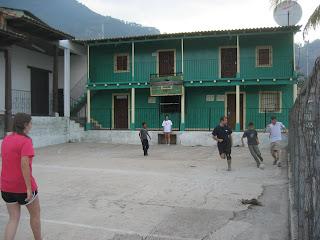 |
| One of the many processions during the week (Photo credit to Ryan Gever) |
We had heard about Semana Santa and the famous alfombras when we first arrived in Honduras. They really seemed to be a national point of pride and our host families were all eager for us to experience firsthand what they were talking about. The word alfombra translates to carpet and the alfombras of Semana Santa are intricately designed 'carpets' of multi-colored sawdust laid out in the streets that generally have an image of Christ and/or other religious symbols in them. In fact, Comayagua, one of the bigger cities that I have yet to visit, is world-famous for their vast array of alfombras, with Catholics from all over making a pilgrimage there every year. Many other cities and villages throughout the country make their own alfombras in tribute, but none have reached the scale and detail that the artists in Comayagua have attained.
 | |
| One of the many alfombras in Comayagua this year Photo Credit to (Muni Comayagua website) |
A dedicated youth group in Yuscaran has been dabbling in alfombra-making over the past few years and, as mentioned before, we were fortunate enough to be invited by one of the members of this group, Adam's host brother, to help out where possible with the creation of the alfombra for this year's Semana Santa. After a day of soccer and lounging in a pool, I took a two hour post-dinner nap to prepare for the all-nighter; reason being, we had to wait for the Silent Procession to pass through the street we were to use as our canvas, and this wouldn't happen until around midnight.
 |
| This is dedication - walking through the streets for close to 2 hours in silence and darkness... (Photo credit to Ryan Gever) |
So, the group of 15-20 of us got to work, first marking out the area with 2X4s - roughly 40ftX15ft. We laid down an initial several layers of rougher, thicker sawdust to fill in the cracks of the cobblestone street and to serve as our canvas. Being a bit timid and unsure exactly as to what was going on, we volunteers primarily helped out with this part of the design, as it was pretty hard to mess up. We sprinkled the sawdust with water so that we could pack it in tight using heavy, large metal poles. It was a tedious process, tamping 6000 sq ft with the end of a 12lb metal pole that had a surface area of maybe 1 sq ft.
 |
| Spraying and tamping, spraying and tamping (Photo credit to Ryan Gever) |
Once the base was set, the real artists went to work. They started by building out the border with fine red and pink sawdust, then filled in the majority with a bright yellow. Next, they broke into teams, some working on the floral designs in the border and one team working on the large, intricate designs in the center. They laid down cardboard stencils that they had cut out earlier in the day, and filled them in with pink, red, black, brown, green, and blue sawdust. To our untrained eyes, with the stencils still in place, we weren't very impressed and sort of scratched our heads as to the extent of time and effort put into making something that appeared to be quite amateurish. But that was likely the drowsiness kicking in... Around 4am, with no clear end in sight, the majority of us PC volunteers decided we had done our part and were of no use any more, so we called it a night, leaving the dedicated crew of 12-15 Hondurans hard at work.
I woke up around 7:30am like a kid on Christmas morning. I was excited to see the final product! I raced out of my house with my camera where I ran into a couple of the other volunteers who had been helping just hours earlier. And there she was, in all her glory: Yuscaran's 2011 commemoration to Jesus during Semana Santa. I'll let photos below tell the rest of the story.
 |
| Our alfombra, with some of the work crew staring on admiringly (Photo credit to Ryan Gever) |
 |
| Sawdust Jesus, pretty impressive! |
 |
| One of the floral designs decorating the border |
 |
| The moment we'd worked towards |
 |
| A collage of photos of the building process Click to enlarge, your reward for having made it this far... (Collage credit to Adam Dittemore) |
Talk about a unique way to celebrate the first hours of my 29th birthday! The remainder of my birthday celebrations was also memorable, but in a considerably different way...


















